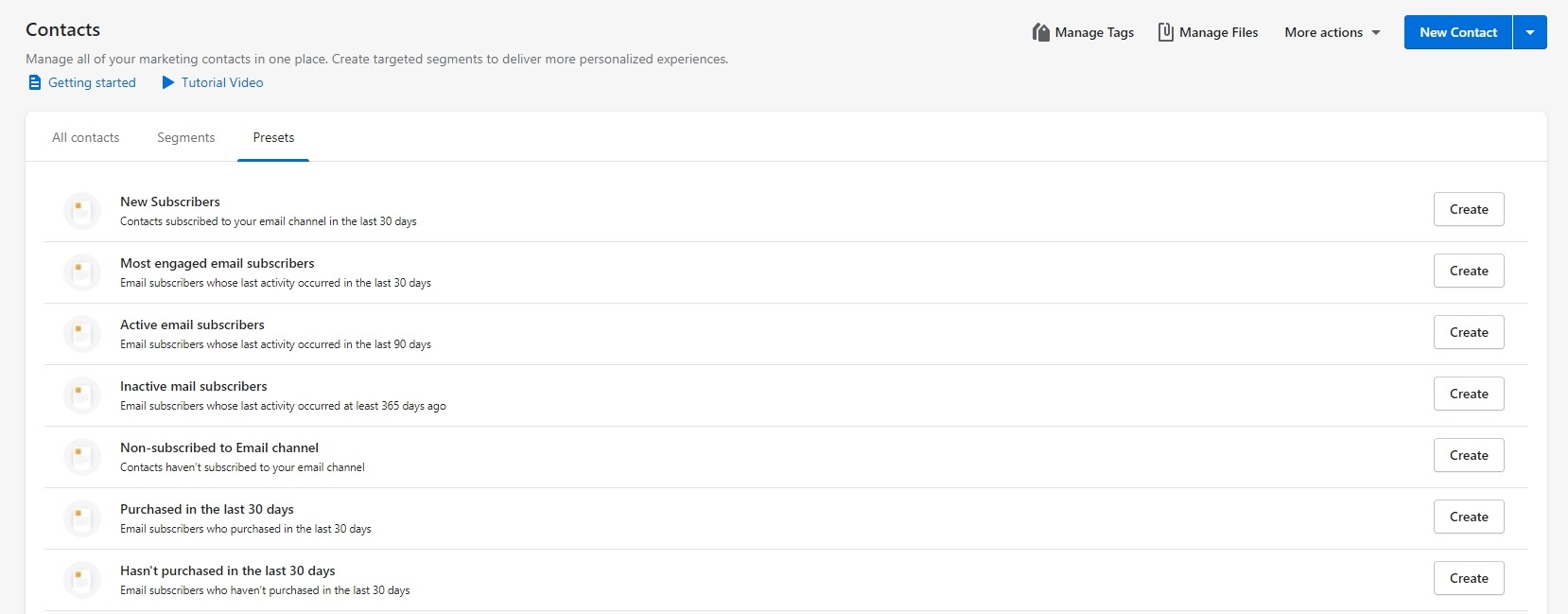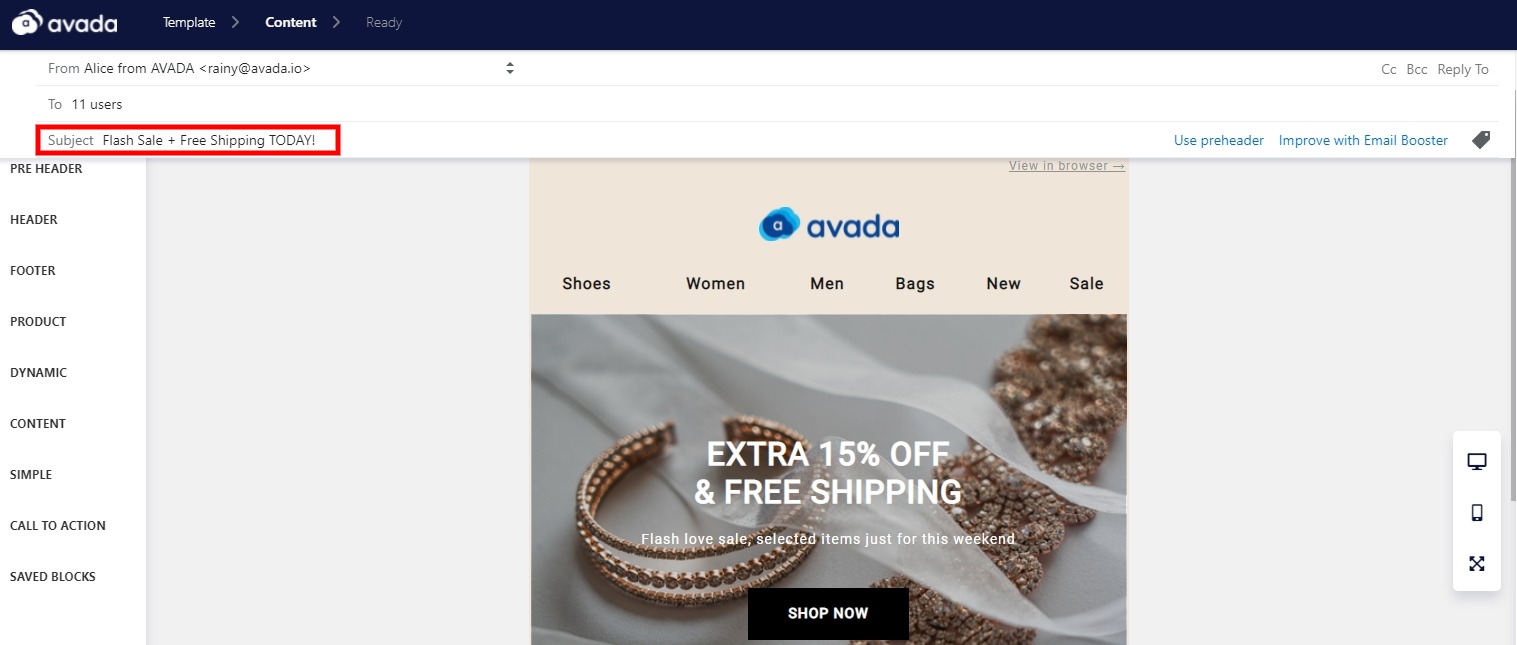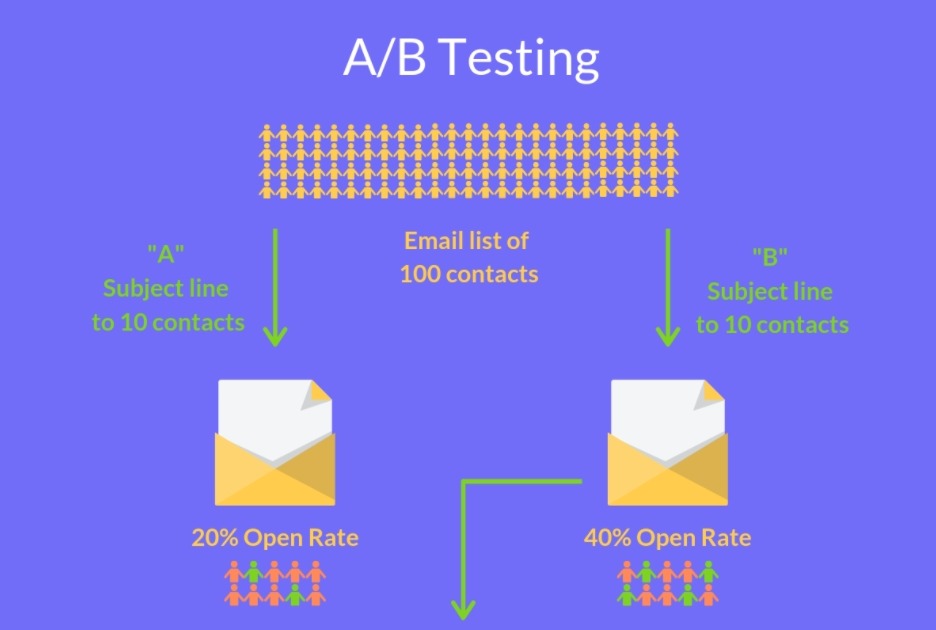Email Subject Line Testing: Guide, Templates & Tools
Email subject lines are always on top of the minds of email marketers. Not only are they tied directly to open rates, but they are also what people see first with your emails in their inboxes and form an opinion about your brand. Therefore, email subject lines must constantly be tested, improved, and optimized for the best result.
That is what this ultimate guide for email subject line testing aims for - helping you brainstorm and optimize the email subject lines of your campaigns. However, don’t take this as a series of steps to test every subject line you write. Instead, use this guide as a catalyst for you to consider and then A/B test different subject line ideas to know what your audience responds to best.
So, get ready to rethink all of your go-to subject lines and start testing out to find the best variation using this guide. Let’s get started!
Why should you test your email subject lines?
First, let’s have a quick reminder about why email subject lines are so important. If you are an email marketing professional, you already know how crucial it is to craft strong, catchy email subject lines to attract your audiences.
According to data, it is estimated that an average person receives 92% emails a day (which is already a lot). At least 47% of subscribers decide to open an email or not solely based on the subject line you write.
In other words, a lot of benefits for your emails can come from optimizing your email subject lines, which means you shouldn’t leave them to gut instinct. Instead, you must get data to improve them constantly.
A subject line test is simple enough: You send an email to two small portions of your list. Then, you look at data to see which recipient group opened your email more, then send the version with the winning subject line out to every subscriber.
Of course, the subject line testing can also get more complicated than that, with:
-
Testing subject lines against different variants
-
Adjusting the size of the list that you use to test subject lines
-
Having longer waiting time before choosing the winner
-
Judging the winner email based on the click through rate instead of the open rate
But you don’t need to start with a complicated subject line testing system. I will guide you through the process of testing the subject line in the next section.
How to test email subject line?

A/B testing an email subject line is easy. One subject line vs. another. A duel to see which is the most enticing. From a technical standpoint, you only need to click a few buttons with an app like AVADA Email Marketing to test the subject lines.
But the much harder question is: What should you test with your email subject line? When you test the words, it’s easy to come up with some sentences and throw them at the test. It’s actually a lot harder to create a test that you can learn from and optimize all of your future subject lines.
This section will help. I will walk you through the fundamentals of email subject line testing.
Step 1: Choose the audience segment

Your emails really can’t please everyone, nor should they try to. The point is not to create the greatest email subject line the world has ever seen (though if you do, kudos). The goal is to understand which type of subject line resonates with your unique audiences. The best approach to do that is by targeting a specific audience segment.
For example, an eCommerce store selling Christmas gifts is better served writing one email version to her list of young gen Z who are eager to buy themselves a present, and a different version to a list of parents concerned about what to buy for their kids. That eCommerce store likely won’t use the same email subject line for both groups.
Think about what aspect of the email marketing campaign, content, or action speaks best to your particular audience segment, then you can brainstorm the subject lines.
Generally, it’s easier to test your email subject lines if you’ve already had segments for your email list. A marketing automation solution like AVADA Marketing Automation can help you easily manage email segmentation with tags and attributes that group subscribers based on common traits like purchasing behavior, open rate, active status, geography, and more.
Step 2: Decide what aspect to test

It’s easy to get into a testing fever and feel tempted to try just about everything you can think of to test. Try to resist that impulse. You should test one aspect of the email subject line at a time in order to get accurate results.
Here are some most commonly tested attributes:
Words and tone
Even adding or removing a single word can make a huge difference in how the audience responds to your email subject line. For example, you can test two nearly identical subject lines such as:
-
Why You Would Be Crazy to Pass On These Christmas Gift Ideas
-
[Lookbook] Why You Would Be Crazy to Pass On These Christmas Gift Ideas
Even though option two includes just one additional word, it could actually net the email a 30% increase in clicks. If your email list has 50,000 people, a 30% increase means you have 1,500 more people clicking and accessing your website or online store.
Length
Common wisdom suggests that high-performing email subject lines should be shorter (about 50 to 65 characters or six-to-seven words) rather than longer. This length is more than enough for your subject line to say what it needs to say.
There are exceptions, of course. Many email marketers are probably still in awe of the single highest grossing email campaign the Obama team sent, which had the subject line with only one word, “Hey.”
However, what works for the ex-president’s audiences won’t necessarily work for us. Until you actually test shorter versus longer email subject lines, you won’t be able to tell what your audience wants.
Design
Don’t forget that you can test how your email subject line looks. Even small changes in design can mean thousands or more additional email opens.
Emojis, punctuation, all caps, and spacing can all have an impact on your email metrics. However, design carefully with these tests, as the wrong combination can lead to your email being in the spam folder.
Personalization
Crafting personalized email subject lines that either include the subscriber’s name or company have been popularly considered an effective marketing tactic, especially with the help of sophisticated email marketing software. You can also test personalization by using the word “you” in the subject lines:
-
Important Fashion Items To Welcome 2021
-
Important Fashion Items You Must Have To Welcome 2021
For some companies, having a subject line like number two, personalized with “You Must Have,” can earn the email a much higher open rate. Again, take this info to test and don’t make assumptions. Your email audiences are getting savvier through each email, and while personalized subject lines may have impressed them in the past, don’t think they can have the same impact today. Always test your email subject lines to find which aspect you should change or improve.
Step 3: Test a small portion of your list
If your list has enough subscribers to create credible sample sizes, you should consider testing you subject line with only a portion of the list. By doing this, you can determine which subject line is more likely to give you the best results, and then the strongest contender will be sent to the full list.
Many email marketers like to A/B test the entire list, and this works better when you have a smaller list. However, if you test the full list, you already send the weaker-performing email subject line to half the email list’s recipients.
Most email marketing softwares offers A/B testing features, and you can easily split test email subject lines. Suppose you don’t have an email client or automation software. In that case, you can manually test the subject line by splitting your email list into different segments and sending a different subject line to each group.
Remember to try to email your testing segments as close together as possible (same time or day) to eliminate other factors in the comparison of the results.
Step 4: Analyze the test results
If you are a proud data geek, then this step is your happy place. Once the email subject line testing results are in, you can start analyzing the data.
During the analyzing process, keep your eye on the testing goals. Opens and click-through rates are important, but what you should consider the most important is always going to be conversions. Even if you see one subject line having a greater number of opens, it doesn’t also necessarily lead to more conversions or even click throughs.
Don’t be afraid to dive deep into your testing results. You can pull out a lot of exciting and important data. You may discover that even though subject line One had a better open rate, subject line Two was preferred by recipients in the 25 to 35 age range. This data can show that you should segment your list differently for your next email campaign.
Step 5: Keep testing

Email subject line testing is not a one-and-done step, and it’s not a chore either. The foundation of solid email marketing rests upon constant testing and optimization. Maybe your first test taught you that the subscribers prefer shorter subject lines. Great news: Next time, you just need to use a shorter subject line and test a different design feature or personalization.
Keep testing because your subscribers change. Audiences can like a certain type of popular subject line at the moment, such as those having emojis, but quickly get used to and can start ignoring these subject lines.
Every time your email communicates with the audience, you have an excellent opportunity to test, change, and improve your messages. The more you are able to improve your email communication, the better your messages can resonate, and the more your recipients will reward your effort with more clicks and loyalty.
Great emails are built upon data and experience, not gut instinct. Testing your subject lines is the best tool to help you gain a better understanding of the audience. After testing with the email subject line, you can split test many things else, including the email teaser, preheader, content, images, design, call to action buttons, and more.
4 Email subject line testing tactics to copy

You can always write a subject line and let it fight against any other subject line. But when the winning subject line steps on and the loser gets to die (gladiator-style), do you really know what you have learned for the next email?
Here are 4 email subject line testing tactics that you can copy to better select your winner and know what to do next.
Test clarity versus clever
Is it better to sound intelligent or be completely clear with your subject line?
Many email marketers are firm advocates of clarity since it’s hard to sell things if recipients don’t understand what you’re selling.
But with email subject lines, the line is blurry. You still should be clear in the email’s body, but what if a bit of clever wordplay can get more people to click? Sometimes it’s easier to create a sense of curiosity among readers by being clever.
On the other hand, cleverness has its own risks of being out of touch with customers. A value proposition is always more simple to follow.
-
The danger of cleverness: Subscribers can’t understand why your email is worth opening, so they ignore it.
-
The danger of clarity: Subscribers don’t think the values you’ve stated can apply to them, or the subject line sounds boring, or they don’t believe that your company can deliver it.
An example of these types of subject lines can be like this: Imagine you are sending an email about a blog post sharing the exercise’s benefits for mental health.
-
Subject Line 1: Exercise, meditation, and…magic?
-
Subject Line 2: This if for when you worry all the time
Can you guess the winner? Me neither. The point is that you can test your subject line using this tactic. That is why testing is valuable for email subject lines, you can also receive results about how your audience wants to see your value proposition. Maybe you should be more clever, maybe you should be more clear, that is for you to decide.
Test short versus long

Email subject lines should be short (about 50-65 words), that is what everyone says. But not necessarily. Sure, there’s lots of data that study the impact of subject lines and suggest a certain number of words. But if you dig through them, you would find a lot of contradictions in the length too.
But what matters is the length that works for your audience. If you sell to people who mostly open emails on their laptops, you should format your subject line to be suitable for those desktop users to open and less care about the suitability for mobiles.
If you have a quirky brand that the audience uniquely loves that trait, maybe creating an all-emoji subject line can work. And maybe people are so used to seeing 50 to 65 character subject lines that you should break the pattern to stand out.
The point is, this is another aspect worth testing for your email subject lines.
-
The danger of being short: Not having enough space to be interesting
-
The danger of being long: Might get cut off by email providers. Sometimes it can sound rambly.
In the picture above from my inbox, I was immediately drawn to subject lines by Mark Manson and Neil Patel, both were incredibly short and in a normal sentence format. Well, I opened both.
Test statements versus questions
A curiosity-inducing question is one of the best ways to create curiosity among readers. But do questions always have the upper hand compared to statements?
Maybe. A fantastic question is how you induce curiosity. However, sometimes it’s hard to have a really good question and introduce the subject of your email well.
Other times your question may just isn’t interesting enough. I ignore many emails that start with “how to get more blog traffic” or something like that, because everyone can have boring questions like that.
Anyways, there isn’t really any big competition of using statements vs questions - except that if you don’t test them, you can end up with a lower open rate.
Whenever you test questions as a subject line, remember to use other methods like combining questions with the different elements to generate even more curiosity. Try to:
-
Use strong emotions (happiness, anger, frustration)
-
Break expectations (just don’t sound like everyone else)
If you want to test a statement as a subject line, you should use a curiosity-inducer as unfinished stories. This is harder to do with questions.
You can use subject lines with a huge surprise effect like “If you have trouble fitting in these jeans, blame your parents” or “I dropped a barbell on my feet” to greatly affect readers. A good statement can easily outperform any question-based subject line it was up against.
Test no personalization versus personalization

Do you know the cocktail party effect? It is when you’re more likely to notice if someone calls your own name. Especially in a crowded environment like a cocktail party (or a busy coffee shop), your brain filters out other conversation happening around and focuses on finding who said your name.
If someone says your name, you perk up and pay attention. This idea is powerful for you to take advantage of in your email subject lines.
Personalization is a fantastic way to make your email stand out in a crowded inbox. Try using geography, names, and other info to personalize the subject lines.
-
The danger of having no personalization: You can have a lower open rate because you sound generic.
-
The danger of having personalization: The subject line can sound creepy if you overuse it, like you hear a salesperson saying your name too many times.
A lot of people don’t realize how much information you can have about them simply by running some ads. Test personalization with your subject lines to find the right balance between personalization and creepy.
It is simple to set up an email subject line test with these examples, you just need a few clicks to try out different subject lines with our app AVADA Email Marketing.
Subject line templates to test
The secret is that the best email copywriters don’t start from scratch. Every so often you or your team can come up with a fun and creative subject line that no one has ever done before. But if you can easily learn from what other companies have done, why wouldn’t you?
There are billions of emails sent every day. Even before email was popular, copywriters were brainstorming headlines to keep people reading. So templates are a great place to start testing your email subject lines copywriting skills. You can always try something shiny and creative that catches your eyes anytime you want.
In the meantime, here are some awesome subject line templates to try testing out right away:
-
Here’s to [type of person] (crazy ones, lovers, best friends, you name it)
-
You look like the type of person who [positive attribute.]
-
Here’s to [your solution’s benefit] (more blog traffic, better skin, an easier life, etc.)
-
The fastest way to [achieve something] (get six-pack abs, fall asleep easily, look amazing in ex’s wedding, etc.)
-
[Do something] like [famous person] (popular like Kardashians, shoot like Jordan, look good like a prince, etc.
-
For when you [experience something] (don’t feel like getting up, are ignored by lovers, can’t concentrate, etc.)
-
Get rid of [a problem] once and for all (dry skin, tired mornings, annoying ads, etc.)
-
The [weird technique] to get [benefit] (Briefcase technique to get a higher salary, Spongebob secret of looking good underwater, etc.)
-
The [famous person] of [a category] (Lebron James of car cleaning, Ferrari of the bike, etc.)
-
[Challenge] (How self-aware are you? Do this test!)
-
The uncomfortable truth about [a topic] (startup, losing friends, working from home, buying in store, etc.)
-
The secret to [result] (falling asleep, looking amazing in summer, etc.)
-
How to [achieve a good result] (make the perfect omelet, dance amazingly, meet your right one, etc.)
-
[Provocative question] (Can sunglasses turn you into a cool person?)
-
This might be the best way to [have a good result] (use social media, buy sandals online, etc.)
-
Why [good thing] is [not so good] (why good socks can be a bad thing, why you should avoid avocado, etc.)
-
How [a famous example] achieves [a good result] (How Mark keeps making millions, How Sarah got a free vacation, etc.)
Subject Line Tester Tools to try out
Another good news is that - you don’t need an email marketing tool to check if your subject line is good enough or not. These next subject line testers can help make suggestions on improvement, check for spam triggers, and give an overall grade on how clickable your email subject lines are.
(Free) Net Atlantic’s Email Subject Line Grader
This tool from Net Atlantic can test the overall effectiveness of your subject line’s copy, word count, word balance and mixture, and more. After that, you can receive a numerical score along with suggestions on how you can improve the subject line. Also, you can find out how your word mixture measures up. You may need a bit more action, power, and emotion, and Email Subject lIne Grader can give suggestions to you.
(Free) CoSchedule’s Headline Analyzer
This tool was built by CoSchedule to analyze headlines of blogs and articles, but it works just fine for email subject lines. Headline Analyzer gives you an overall score for the subject line and provides tips on grammar, structure, and word placement. The tool is widely considered a standard in headline testers, so it is definitely a tool to keep in your pocket when writing a subject line.
(Trial) Email Spam Tester by Glock apps
With paid features for data that you can share with your teams and track over time, Email Spam Tester by Glock apps conducts a thorough grading of your emails with all elements and gives you guidance on how you can improve the email.
Final words
Subject lines are a crucial part of your email since a large part of email recipients open emails based on the subject line. To make the most of inbox attention, you should ensure that your subject lines can grab the prospect’s eye every time. The only good way to do that is by testing the hell out of your subject lines to find what your audience likes the most.
Test your subject lines. Test your emails. Improve them frequently so your recipients drop everything they do when your brand’s name shows up in their inboxes. Best of luck on doing that and feel free to share your result in the comments section!
New Posts






